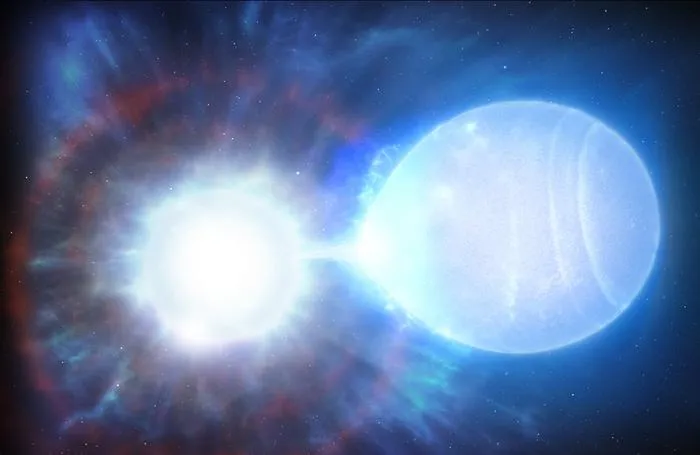Astronomers Discover a Rare White Dwarf Pair Doomed to Explode in a Brilliant Supernova
Astronomers Discover a Rare White Dwarf Pair Doomed to Explode in a Brilliant Supernova
The event will be ten times brighter than our Moon in the night sky, but never fear, it won’t happen for another 23 billion years
An artistic rendering of the moment when the first white dwarf explodes and spews material at the second white dwarf, which itself is about to explode.
Credit University of Warwick/Mark Garlick
Astronomers have discovered a rare pair of white dwarfs destined to explode in a spectacular supernova in Earth’s cosmic neighborhood. The discovery is detailed in a study published Friday in the journal Nature Astronomy.
White dwarfs are the dense remnant cores of dying stars that have run out of fuel; when they gather too much mass for its gravity, they can explode in what's called a “1a supernova.” Astronomers have theorized that supernovas such as these are caused by two white dwarfs orbiting each other in a binary star system, when one of them consumes the other.
The astronomers' discovery marks the first such 1a supernova-causing binary system ever identified, and just about 150 light-years away from Earth—which on the scale of the universe, is actually quite close. This proximity “gives the impression that plenty more of these systems should be hiding in plain sight and we have the ability to identify these systems much farther away,” James Munday, lead author of the study and a researcher at the University of Warwick, tells ScienceAlert's Michelle Starr.
“For years, a local and massive double white dwarf binary has been anticipated, so when I first spotted this system with a very high total mass on our galactic doorstep, I was immediately excited,” Munday adds in a statement.
Munday adds that he realized the significance of the discovery when the team's analysis revealed that the two white dwarfs were separated by just 1/60th of the distance between the Earth and the Sun. Further research also demonstrated that the binary system is the heaviest of its kind confirmed by scientists with a total mass 1.56 times that of our sun's. If the small distance between the white dwarfs wasn't evidence enough of their doomed destiny, their combined mass certainly sealed their fate.
The type Ia supernova explosion of WDJ181058.67+311940.94
Watch on
“[The dwarfs] are both about as big as the Earth. One has a diameter about 20 percent larger and the other about 50 percent larger. That gives you an idea of how dense they are. It's the Sun compressed onto the size of Earth. Their masses when they were regular stars were probably around three to four times the mass of the Sun,” study co-author and University of Warwick astrophysicist Ingrid Pelisoli tells Reuters' Will Dunham.
The white dwarfs are currently orbiting around each other, with each orbit lasting over 14 hours. In time, they will spiral closer and closer, eventually completing an orbit in just 30 to 40 seconds. One white dwarf will siphon matter off the other, triggering a rare “1a” supernova with four separate explosions.
The growing white dwarf will first explode at the point where it is gathering mass, followed by an explosion in its core. This detonation will spew material at the other white dwarf, triggering the same devastating sequence. Overall, the supernova's power will be “a thousand trillion trillion times“ that of the world's most powerful nuclear bomb, and will last around four seconds, per the statement.
“We predict that the binary will explode dynamically by means of a double detonation that will destroy both stars just before they merge," the researchers explain in the study, adding in the statement that the supernova will appear ten times brighter than how our Moon appears in the night sky. Type 1a supernovas' consistent brightnesses are deeply relevant to scientists, who use them as “standard candles" to measure other distances in the universe.
Despite the system's proximity to Earth, the researchers explain that the event won't endanger our planet. Given that they estimate that the explosion will take place in around 23 billion years, however, we won't be around to see it. For comparison, Earth is 4.5 billion years old, and the entire universe is 13.7 billion years old. In fact, Earth itself might not even be around to witness it and the Sun itself might already be a white dwarf.
“Still,” says writer Stephen Luntz for IFL Science, “perhaps some aliens on another world will enjoy the sight.”
Get the latest stories in your inbox every weekday.
More about:
Astronomy
New Research
Outer Space
telescope


